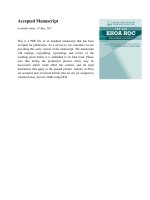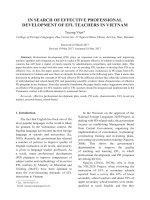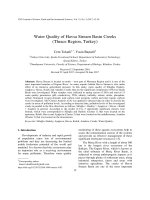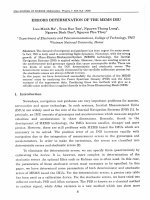DSpace at VNU: Periodic solutions of some linear evolution svstems of natural differential equations on 2-dimensional tore
Bạn đang xem bản rút gọn của tài liệu. Xem và tải ngay bản đầy đủ của tài liệu tại đây (861.34 KB, 11 trang )
VNU Joumal of Science, Mathematics - Physics 26 (2010) 17-27
Periodic solutions of some linear evolution svstems of natural
differential equations on 2-dimensional tore
Dans Khanh Hoi*
Departmenl of General Education, Hoa Binh University, Tu Liem, Hanoi, Wetnam
Received 3 December 2009
Abstract. In this paper we study periodic solutions of the equation
7/A + aa \
:
; (;
)u@,t)
uG(u
- f),
(1)
with conditions
ut-o:'tlt-bt [
Jx
over a Riemannian manifold
X.
@@),r)
d,n:o
(2)
where
Gu(r,t)
:, I
s@,y)u(y)dy
Jx__q
is an integral operator, u(n , t) is a differential form on X , A : i(d+ 5) is a natural differential
operator in X. We consider the case when X is a tore fI2. It is shown that the set of parameters
(u,b) for which the above
measureinCx]R+.
problem admits a unique solution is a measurable set of complete
KEworlrs and phrases: Natural differential operators, small denominators, spectrum of compact
oDerators.
1. Introduction
Beside authors, as from A.A. Dezin (see, [1]), considered the linear differential equations on
manifolds in which includes the external differential operators.
At research of such equations appear so named the small denominators, so such equations is
incorrect in the classical space.
There is extensive literature on the diffcrent types of the equations, in which appear small
denominators. We shall note, in particular, work of B.I. Ptashnika. (see, [2])
This work further develops part of the authors' result in [3], on the problem on the periodic
solution, to the equation in the space of the smooth functions on the multidimensional'tore fI'. We shall
consider one private event, when the considered manifold is 2-dimension tore fI2 and the considered
space is space of the smooth differential forms on fI2.
" E-mail:
18
D.K. Hoi
/ WU
Journal of Science, Malhematics - Physics 26 (2010) 17-27
We shall note that X-n-dimension Riemannian manifold of the class
oriented and close. Let
C-
is always expected
6:O
is the complexified
o€p:$:olye(T"X)eC
cotangent bundle of manifolds X, C-(() is the space of smooth differential
forms
X (see, [4]). By -4 we denote operator i(d+6),
where
d is the exterior differential operator and
manifold
X,
operator
on
so-called natura{ differential
6: d*- his formally relative to the scalar product on C-(0, that inducing by Riemannian structure
on X. It is well known (see, [4], [5]) that d+d is an elliptical differential first-order operator on X.
' From the main result of the elliptical operator theories on close manifolds (see, [4]) there will
and
Hk(€)
is the Sobolev space of differential forms over
be a following theorem.
Theorem l. In the Hilbert space H0 (Q) there is an orthonorm basis of eigenvector {f ,.} , m e Z, of the
operator A: i(d+5) that correspond to the eigenvalues ).*. Else \rn : 'ip*, 1,l- € R, \-^: -\r,
and
,,
, '-. 0 when rn ---+ 6.
lArnl
Proof. This theorem was in [5].
The change of variable t : br reduces our problem to a problem with a fixed period, but with
a new equation in which the coeffrcient of the r-derivative is equal to 7lb:
.a
(#
2. Thus, in fI2
:
R2
-r a(d -r 6))u(r,br)
:
vglu(r,br)
-
f (r,br))
lQV,)2 problem (l)(2) turns into the problem on periodic solution of the equation
Lu
13_ * a(d, * 6))u(n,t) :
= '1,oot
uG(u(r, t)
-
f (r,t))
(3)
with the followine conditions:
ult:o
:
ult:t,
(r(r),7)dr:0.
(4)
Here
/ "o("
u(r,t):(1
O"')l::l:
\
"("
, t e [0,1]; a
coeffr
(u(r),u(r))
- complex form with
ers,
r)u1(r) + u2(
Gu(r,t)
: I s@,y)u(y,t)d'y
Jft2
L2: Lz(Ho(Q, [0, 1]) with a smooth kernel
g(r,v): (s4@,v11, i, j :0,3
is an integral operator on the space
defined on II2
x fI2
f,
such that
gor(r,a)
Jn"( soo(",d
goz(n,a) sos(',v) ) d":
0 vs € fI2'
D.K. Hoi
/ W(I
We assume that operator
u(r,t) € C-(C-(€),
Journal of Science, Mathematics - Physics 2.6 (2010)
aA)
lth+
[0, 1]),
a@* d) given in the-differential form
19
space
with these conditions
zlt:o
Let
: i&+
17-27
: ult:tt [ @@),7)d,r:
J tl2
L -denote the closure of operation
jr* -
a@,
o.
+ 6) in L2(H0(€), [0, 1]).
So, an element
t;f#]- aA), if and only if there
dr:0 such thatlimui : u,
u e L2(Ho(€), [0, 1]) belongs to the domain D(L) ofoperator t :
is a sequence {ui} c C-(C*(6), [0, 1)) uilr:o: uilt:rt !nr@i1r1,1)
limLui: Lu tn fz(Ho(€), [0' 1]).
Let'll-denote a subspace of space 12(I/0(€), [0,1])
11: {u(r,t) e L2(Ho(€),
[0, 1])
| J[tt2 @@,t),7) d,n:0]
We note that
{+i"@+ 4: +ttrlkl;k: (kr,k2) ez2}
is the set of eigenvalue of operator
A:
l(d + 6) on fI2 and eigenvectors, coresponding to
rfi +
are given by the formula:
fn'(r)
\:
:
"ig(kPr
rc/,
* kzr2)'r''
''
is some basic in 4- dimensional space of the
complex differential forms with coefficients being constant. These coeffrcients depend on ,k e Z2 and
elements of this basic are numbered by parameters 4. We are not show a,,1r, on concrete form. (see, [6]).
(h,kz) f 0, are eigenform operator L that
Lemma l. The forms €krnn :
"i2"*tfxn(r),k:
corresponds to the eigenvalues
here
up, e O?:o no(Cr),
(Tr,rlz) e
{-I,*1}2
\knt: " (T + alnlrtr) :ry * ),*n
(5)
in the space H. These forms form an orlhonorm basis in given space. The domain of operator L is
given by formula
: D uk,nn€krnn I llXr,,r"k^rl' <-, I lur^rl' < oo }.
k+0
k+o
k+o
The spectrum o(L) operator L is the closure of the set A: {tr*-ry}'
D(L)
:{
"
We note that the number of dimensions of the eigensubspace is finite and we shall not indicate
exactly how many there are of them.
Lemma 2. Let g(r,A) e L2(fI2
xfI2)
M,
and
: ( [ JT2
t M@,v)ll'o,oo\''''
/
\JT2
- linear operator is bounded in HoG) and his norm
Here llg(r,y)ll - matric norm g
Then G
g(r,a):
llcll3
(9;i@,Y11, i, j -- 0,3
Mg
20
llgll
/ WU
D.K. Hoi
:sup{llezll lue
Proof. If
u(r) € Ho(6)
Journal of Science, Mathematics - Physics 26 (2010) 17-27
JR2xlR2, llzll
llcu(r)ll'
:
|
|
<1}.
<
lr,s@, ilu(a)dalf = (lr"k@, ilu(v)lldry)'
12 r
/ r
^ r
(
<
I
lls@,ill:.
ll"(illlaa
llg(",v)ll2aa'
)
/
I
- Jn2
"'-"'"/
'\Jn,
-Jn2
llculP: Jt2
I llcu(r)ll'd*
t (t
<
I
rrl; \r;1,ttg@,a)tt'.a tn,,tl,(v)t t2da\/
llc"ll'< JTI2
| JfI2
| lls@,y)ll2drdy
llcll a
^
ll"(v)ll'da,
h,
It2 ll"@)ll'da:M&ll"ll',
J
Mo.
The lemma is proved.
Let E: (-A,)o*l,a ) 0. Then E is M-operator in I10(O and Efp, : pkft",t, herc
:
pr (trlkl)'*'o ut" eigenvalues. Operator (-A,)o+1 is self-conjugate. We suppose that kernel
S@,a) of operator G having the following behaviour (-L,)'+'gni(r,A) e L2(fI2 x II2) @tiGA)
belongs to space Sobolev W]+z* for almost every a € II2). Then product operator E G is integral
"
operator (-A,)t+' o G* with kemel
(-L")'+'g(r,a): ((la")t*'g
Let
M:
Lemma
oi)@,a)), i,,i
:d3.
,
max{ll(-A,)t+'o cll, llcll}.
3. Let u : Gu : Danrnnek nrll then
lu*'"nl'=
-
,,
,1Y:'l9ll:
-.,
((zrlkl)z+za 11)z'
(6)
Ifk+0then
lr*^rl', --
lo*'n
l'
61r1;'*2a 1r)z'
here
dtemn
: ((-Ar)t+' o Gu, eprn
)
7r.
Proof. We have
: ((-A,)t+' oGu,e*,n j)"r: [ ((-A,)t+' oGu;en,nn)at: [' pr.r, (-A,)1+ oep,n )dt:
Jo
Jo
pr
pl
I (C", p'6ep,n )dt : T,,Jo| (Gu, ep, ,,1)dt : px(Gu, en^n) b : prkak,n r.
JO
Then, if px * 0 ( so that lp*l > 1) we have
ekrnn
4lon'"12
lut"'nqtt2 -" (lP*l +7)2'
Thus, by Parseval dentity
\,lo*,,r1':
ll(-A,)'+2" o Gull2 < u'll"ll'.
D.K. Hoi
/ WU
Journal of Science, Mathematics - Physics 26 (2010)
17-27
2l
So that
aqt
lup--12
In the case F*
:
O
by Parseval dentity
l,
*,n
t-
!M2ll"ll2^
(|prl +1)2'
Dlrr,.rl' :
llGull' we have
l' < c |l' |l, |l' s +llc
||
rw" Wll?
< (lt"nl
t)''
+
ll' llull2
+
=
The lemma is proved.
' We assum e that a is real number. Then by Lemma I , the spectrum o (L) lies on the real axis.
The most typical and interesting is the case where the number abl2 and, (abl2)2 are irrational. In
this case, 0 * \n^n
e V,.,k € V],k I 0 and, the H.Weyl theorem (see, e,g., [7]) says that, the set
of the numbers )6-n is everywhere dense on IR and o(L): IR. Then in the subspace'Jl the inverse
operator .L-1 is well defined , but unbounded. The expression for this inverse operator involves small
denominators [B].
L-ru(t,')
:t
(7)
??"*,,r,
,,KnrI
where the uprn, are the Fourier coefftcient of the series
\/2
u(r,t):
me
For positive numbers
C,o
let
A"(C)
denote
th!
tce
set
\
I\
,\x,ntl >
ukrnn€kmn.
2
k+0
of all positive b such that
C
(8)
lkF*
for all rn e Z,k € 22,rl : (\r,Tz),Tr2 - 11, k + 0.
From the definition it follows that the set A"(C) extends as C reduces and as o grows. Therefore, in what follows, to prove that such a set or its part is nonempty, we require that C > 0 be
sufficiently small and o sufficiently large. Let Ao denote the union of the sets ,4., (C) over all C > 0.
If inequality (8) is fulfilled for some b and all m,le , then it is fulfilled for m : 0; this provides a
condition necessary for the nonemptiness of A,(C):
C
6:
k+0.
(e)
C < d,12.
Theorem 2. The sets Ao(C), Ao are Borel. The set Ao has complete measure, i.e., its complement
We put
laltr
and
to the half-llne IR+ is of zero measure.
oo
Proof. Obviously, the sets A"(C) are closed in lR+. The set Ao : l)
r:l
1,"1t1r1- is Borel,
being
a countable union of closed sets. We show that Ao has complete measure in IR*, Suppose b,
0,
C<
d.
|t
I)
we consider the complement (0, l)\A"(C). This set consists of all positive numbers
for which lhere exist m,k,k
f
b,
0, such that
l\*rrrtltffi
(10)
D.K. Hoi
/ WU
Journal of Science, Mathemqtics'Physics 26 (2010) I7-27
Solving this inequality for b, we see that, for
Ik,rr: (*on,m/n), where 'trl: I,2,3,'.',
ak
21
: ----------e-,
;i;
Itcl-'-
lanlkll+
The length
of
C
(
d
i
0n
f
0 fixed, the number b forms an interval
2r
: :--..:----Tlanlkll
lk|+"
l6,rn is rnd1", with
6k:
Since
m,k,k
4rClk1-t-"
lanlkllz
- Qzlftl z'zo
bV assumption, we have
76nc
dr:> 5lk[+'E;lElP'
(1 1)
For k fixed and m varying, there is only a finite amount of intervals lp,n that intersect the given
segment (0, l). Such intervals arise for the values of m : 7,2..., satisffing rma.p I I, i.e.'
o
Since
Clkl-|-o < ,lanlkll,
:
+ clt;-l-";.
l(-nltll
2r''
we can write simpler restrictions on ?n
o
3n
<
<
n'L
<
ffi|"*tnt1.
:
!-Pnlnll.
(12)
The measure of the intervals indicated ( for k I 0 fixed ) is dominated by d1,^9t, where
Sn(t) is the sum of all integers rn satisfying (12). Summing an arithmetic progression, we obtain
Sr <
ffVrlkll{Ilanlkl
Considering the union of the intervals in question over
p((0,1)\A'(c))
^9: S(l)
:
< t
k+0,ke
t
k
|
+'}.
and
(13)
m, and using (11), we
!
SnSx
see that
< CS(I),
2
8l{tlatrlkll+
"} '
,3rlklr+ola"lkll
+o,k<
Observe that the quantity
is dominated by a constant D, therefore, (since o
s1r; <
>
t
0)
1
lrr k+0,k€ , lklr+' < oo'
We have
p((0,,) \ A,) < p((0,,)\ A"(C)) s CS(I) VC > 0.
Itfollows thatp((0,1)\A") : g Vl > 0. Thus, p((0,oo)\.4") :0 and -4o- has completemeasure.
The theorem is proved.
D.K. Hoi
/ WU Journal of Science, Mathematics
Theorem 3. Suppose S@,a) € L2(fI2 x II2) such that
and
- Physics 26 (2010)
(-A,)t+'g(r,g)
f
| ( soo(r,il go{r,v) goz(r,a) sos(r,0 ) d'r :0
JT2
17'27
is continuous onfl2
Ys efr2
23
xfI2
'
and letb e A"(C). Then inthe spaceH theinverse operator L-L iswell defined,
and the operator L-L o G is compact.
proof. Since b'e A"(c),we have \n*n #
0 so rl:frlt,rn" space Tt,
Y m e z,k e 22, k
Let0 < o
1!,
0
-t-1
l,kl
I
is well defined and looks like the expression in (7). observe that lim
G#E;Try:
0
as
-+oobecause0
lbl2+2o
for all lkl 2 ko'we write
G#$Try'ffi
L-7u(r,t):
Qhru *Quozu,
u:
Gu,,
where
Qkorr:
t
o<1*-1at
o
Y"r^r,
Ak*n
t Y"r,,r'
o*^'
Q*oru:
|
714,
For the operator Q*0, we have
lrx^rl'
llQro"ll':
l\x^ql2'
0
Observe that
if 0 < lkl
Therefore, the quantity
(
ke, then
,*: *
I A
:0.
Iim ^' t
lrnl*oo
l# * anlklq2l2
is dominated by a constant C(k6). Then
attlcl\21- "
lle no,rll' <
t
luk,.rl2c (ks) < c(ks) | lol 12,
which means that Q po, is a bounded operator.
Consider the operator Q*oro G. By Lemma 3 and (8), we have
llQn*rll2
\-
:
llQuo, o Gull2
: > M
lffik"l^r"nnl =
(L\2w12+2"
,=l3f?:l' t;zt
-'c' '*'
* ,.^ cl t'"t s*fr*),
,rfrr{{"lttl)z+za
t
lor^rl2
,r,uro
Consequently,llQuo, o Gll S e.
Since G is compact and Q;,o, is bounded, Q*o, o G is compact. Next, we have
lll-t
oG
-
Qno,
oGll:
llQro," Gll <
e.
Thus, we see that the operator L-7 o G is the limit of sequence of compact operators. Therefore,
Ka L-r o G.
compact itself. The theorem is proved. We denote K
:
:
it
is
Theorem 4. Suppose b e A"(C). Then problem (1)(2) has the unique periodic solution with period
bfor all u €C, except, possibly, an at most countable discrete set of values of u.
24
D.K. Hoi
/ WU
Journal of Science, Mathematics - Physics 26 (2010) 17-27
Proof. Equation (3) reduces to
(L-roC-L)u:L-r"G(f).
u'
L-roC-!:N-!.
UU
Since 1( - L-'o G is a compact operator, its spectrum o(1{) is at most countable, and the
limitpoint of o(K)(if any) can only bezero. fherefore,the set S: {, +01!
eo@)}is atmost
'v
Wewrite
countable and discrete, and
for all u I 0,
,f
,9 the operator
(K
is uniquely solvable. The theorem is proved.
We pass to the question about the solvability of problem
- ;) ir invertible,
(l)(2) for ftxed u.
the structure of the set -E C C x lR+, that consists of all pairs (2, b), such that u
l0
i.e., equation (3)
We ne,ed to study
and
:
4 o(Nu),
Ku: L-r oG.
Theorem 5. E is a measurable set of complete measure in C x IR+.
where
For the proof we need several auxiliary statements.
Lemma 4. Forany e > 0thereexists anintegerkssuchthatllK6-kAt
o 17,, where r :7,2,..:,
K6u: La-ru:
t ffi"r*r,
for all lkl > ko, 0 < o
(
1,a
)
(Ko
Ukrnn
k6u:
Proof. Observe that for any 6 > 0 there is an integer ks such
0. We have
\
/1\ vKnln'
krnn\o )
-p, lbl2+2o
ffrar
< (ft)' .' t
' ((zr'lf r'"1
;;z+2a 11)2
- k6)u: K*ouu: t ffi"r,.,
"Kmrt
lk1>ko
||
(r(b
- friul|2 :
11Kooou112
:f
|
l*t'l>ro'
,,(h), \
lor,-rl,
.'*-7,, l' <
r,i?,1!3']!,1'l'i,u
-,?,rro
\x,",t(b)'
((trlkl)z+2" i 7 1' =-
<,r(h)rurllull,
:
K6 is continuous for
t e 41!1.
I
url)ullr.
lkl>ko
Thus
llXa-
frull
:
llI(/.rrll < 6 as required.
Lemma 5. The operator-valued function b
Proof. Suppose b,b + Lb e
---+
A,(:)
and e
-
S llfra+ra
> 0. By Lemma 4 there exists an integer ks (independent
-, : llK*oull < e and llKo+aa Ku+mll =
of b,b + Ab) such that ll-8 - Kbll
llKro(ataa) ll < e. Next,
Ku+ta - Kb: (fra+n + o(a+aa)) - (kur Kxoa),
whence we obtain
lll(a+aa
Kbll
- kal*
llKro(a+ab)ll
+ llKroall.
/
D.K. Hoi
WLI Jounal of Science, Mathemqtics - Physics 26 (2010)
Considering the ope ators .k6-'a6, -fr6, we have
\
(
(frr*oo-fr6)u: t
o
\*'n't(b +
t
- *+!f,-,,
lb(b+Zb)l'O
4m2r2
-.
(14)
l\n"r(b)lt
t .'::.. r:, o < o < 1, then
I la1",n l2r2lklz+2" s r2ko2+2"lr*,n l''
6ffiW
The
25
AP'nn\D)'
Ab) -tl^ll)terrut€ternrl
--va^v'"
llkou - fru+mu1,
If b+ Ab e A"(;),
17'27
4m2n2
4m2r
,.,
:
-t k6 :----r-..L^++L^^,,^-+:
^ \<-ttt
r'v guantit'r
t'*t the
imply that
: b"t andthe
condition 0
uullulllurru
l,kl \< tuu'rrPrJ
lrul
t'J-Ar'-n@)12
m'-'x 1a1"rn1\0)l'
relation hm
4m212
|
rs dominated by a constant
c(kd
depending on ks. Therefore
+ anlklTt2l2
lAbl2 =-Lb)l'
[00+
lux,,rl'
o.?r
lAbl2 t
/t
'-Abtiz
lb(b
r-\- +
4m2r2 .,
+ Ab)l2l\x*n(b)l'
-
r2koz+zo"rko)lu*,_nl2 S
oai-*<*3
labl2
tatJiioltz '2koz+z""T
Since
t
lrx,n
-
|
o'
t
l'**'l''
0
l'< llrll' < u'llull",
0
we arrive at the estimate
llfrr*a,
We choose
- kSf'= frffi
M2r2ko2+2"c@o).
Ab so as to satisff the condition
x42r2po2+2oc&s) < e.
-lAqi+ Ab)1-
lb(b
fhen llKa+m- Kull < 3r.This
A"(;).The
shows that the operator-valued unction b
---+
K6 is continuous on
Lemma is proved.
Lemma 6. The spectrum o(K) of the compdct operator K depends continuously on K in the space
Comp(1ld of compacr operators onHo, in the sense thatfor any e there exists 6> 0 such thatfor
all compact ( and even bounded ) operators B with llB - Kll < 6 we have
o(B) c o(K) + %(0), o(K) c o(B) + %(0).
Here
V,(0): {^ € A I l^l < 6} ts the e-neighborhood of the point 0 in C'
(15)
26
D.K. Hoi
/ WU
Journal of Science, Mathematics - Physics 26 (2010) 17-27
Proof. Let K be a compact operator; we fix 6 > 0. The structure of the spectrum of a compact operator
shows thatthere exists e1 < €12 such that q # l^l for all
e o(K). Let ^9: {4r,..., );} be the set
^
of all spectrum points ) with l)l > er and let 7 :
U %, ()). Then V is neighborhood of o(,K)
)€su{o}
and V c o(K) + %(0). By the well-known property of spectra ( see, e.g.,[9], Theorem 10.20) there
exists d ) 0 such thato(B) CV for anyboundedoperatorB with llB-Kll < d. Moreover(see, e.g.,
[9],p.293, Exefcise 20),the number d'> 0 can be chosen so that o(B)n%r()) +AV^ € ^9U{0}.
Then for all bounded operators B with llB - Kll < d the required inclusion o(K) c o(B)-1V2,,(0) C
o(8,) * %(0) and o(B) cV c o(K) + %(0) are tulfilled. The lemma is proved.
From Lemma 6 we have the following statement.
Proposition l. The function p(),, K): di,stQ,,"(K)) is continuous on C x Comp('Hs).
Proof.Suppose.\eC,KeCornp(T{s)ande>0.ByLemma6thereexists6)0suchthatforany
operator fI lying in the d-neighborhood of K,llH - 1{ll < d, the inclusions (15) are fulfilled; these
inclusions directly implythe estimate lp(^,1() - p(A,f/)l< e. Then for all p €C with lp - )l < e
and all fI with llH - Kll < d we have
lp}r,K)- p(^,H)l< lp}",K)- p(^,rc)l+lp(^,K)- p(^,rr)l< lp- rl *e
Sincee)0is
arbitrary,thefunction
<2e,
p(x,K) iscontinuous. Thepropositionisproved.
I and Lemma 5. we obtain the followingfact.
p(),,b): d,ist(\,o(Ku)) is continuous on (),,b) e C , A"(:).
Combining Proposition
Corollary
l.
Thefunction
I
Now we are ready to prove Theorem 5.
Proof of Theorem 5. By Corollary 1, the function p(\f v,b) is continuous with respect to the variable
(v,b) e (A
\ {0}) , A"(:).
Consequently, the set
B,:{(u,b)
|
p(\lr,b)+0,
Ue,n"1!1y
is measurable, and is so the setB: l)rB* Clearly, B C E and E: BU86, where Bo: E\B.
Obviously, Be lies in the set C x (R+ \ A") of zero measure ( recall that, by Theorem 3, Ao has
complete measure in IR+ ). Since the Lebesgue measure is complete, .86 is measurable. Thus, the set
E is measurable, being the union of two measurable sets. Next, by Theorem 4, for b e. Ao the section
Eb:{r€Cl(rz,b)eE}hascompletemeasure,becauseitscomplement{Tlulueo(K6)}isat
most countable. Therefore, the set ,E is of
full plane Lebesgue measure. The Theorem is proved.
The following important statement is a consequence of Theorem 5.
Corollary l. For a.e. u e C, problem (1)(2) has a unique periodic solution with almost every period
beR+.
Proof. Since the set E is measurable and has complete measure, for a.e. u e C the section E, :
{b e
IR+ | (r, b) e n\: {b € IR.+ | t/z 4
has complete measure, and for such b's problem (l)(2)
"@u)}
has an unique periodic solution with period b. The Corollary is proved.
Aknowledgments. The work is partially supported by the study QG-10-03.
e
D.K. Hoi
/ WU
Journal of science, Mqthematics - Physics 26 (2010)
17-27
27
References
lll
A.A. Dezin, General questions of theory boundry- value problem, M., 1980. @ussian)
B.I. ptashnik, Nekorrektnie granichnie zi;adachi dlia differencial'nih uravneniy s chastnimi proizvodnimi, Kiev, "Naukova
Dumka" (1984) 135-141.
periodic solutions of some differential equations on multidimentional tore, International Conference
t3l Dang Khanh Hoi,
"Midernprobleps of mathematics, mechanics and their applications," (Moscow, March 30 - April 2,2009).
Press, Princeton,
R. palais, Seminar on the Atiyah-Singer index theorem, In. Ann. of Math. Srzd., No 57, Princeton Univ.
l2l
t4l
N.J, 1965.
(Russian) [J] Dffer. Uravn. 5 (1969) 186.
t5l pham Ngoc Thao, Natural differential operators on compact manifolds,
periodic
pham
systems of natural equations on Riemaniann
evolutional
of
the
solutions
Thao,
Ngoc
t6l Datrg Khanh Hoi,
(l), Acta Mathematica Wetnamica, Vol.13, No 2 (1988) 3l'
I.P. Kornfeld, Ya.G. Sinai, S.V' Fomin, Ergodic theory,"Nauka", Moscow, 1980'
manifolds
I7l
P'l5l'
of model
periodic solutions
t8l A.B. Antonevich, Dang Khanh Hoi, On the set of periods for
(2006)
1041.
8,
T.42,
No
equations, DffirUravn.,
York' l99l'
tel W. Rudin, Functional analysis,2nd ed., McGraw-Hill, Inc., New
quasilinear differential









